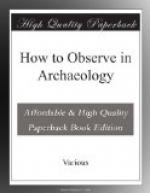2. Persian (Achaemenian) period: c. 540-330 B.C.
This period is distinguished from the former by the less frequent use of bronze, the introduction of coinage, and the development of the simplified Persian cuneiform writing (never on tablets, only on stone monuments; see XV, Fig. 18). Bitumen ceased to be used as mortar in buildings. Persian walls (e. g. the Apadana at Babylon) are easily distinguished by the use of clay mortar, and the unusual thickness of the mortar-courses between the bricks. Burials in shallow trough-like pottery coffins, with the bodies at full length, but with the knees slightly flexed (these continued during the next period).
VI. MIDDLE IRON AGE: 1. Greek and Parthian periods; c. 330 B.C.-220 A.D.
Characteristics. Sudden degeneration and disappearance of the ancient native civilization and art; imitation of Greek culture, Greek buildings (theatre at Babylon), and inscriptions; Greek legends on Parthian coins; Parthian kings call themselves ‘Philhellenes’; Graeco-Roman architecture imitated (Hatra). Graeco-Roman terra-cottas, pottery lamps, pilgrim-flasks and bone-carvings; classical seal gems; Roman glass; fragments of imitation of classical sculpture in marble (the material being adopted as well as the style); and, of course, coins—these are characteristic remains found on mounds of this period. About l00 B.C. the use of cuneiform was given up; clay tablets were no longer used. Aramaic became the usual form of writing; ink used on sherds; wax tablets. Small bowls often found with ink-written incantations in Judaeo-Aramaic (see XV, Fig. 19). Mounds of this period are perhaps most easily recognized by the quantities of deep-blue glazed sherds found lying about on them. The glaze is rather thin, laid on a coarse drab ware, and is often cracked. The blue is very fine, rivalling the old Egyptian. Burials of this period are often found in (besides the shallow pottery coffins mentioned above) rectangular oblong boxes of thin coarse ware with light friable blue glaze (Babylon), or (later) in slipper-shaped coffins (possibly Sassanian) of the same ware, rudely




